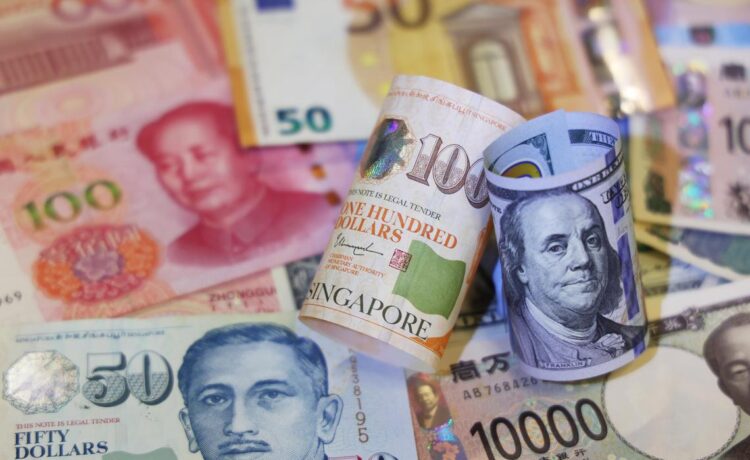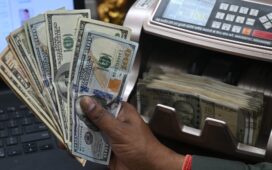SINGAPORE – Asian currencies rallied on May 5 on hopes of a thaw in the US-China trade war and regional tariff deals with the Trump administration.
Taiwan led the charge, with its currency surging as much as 5 per cent, the biggest intraday gain in over three decades, on speculation that exporters are rushing to convert their holdings of US dollars to the island’s currency.
The Taiwan dollar has advanced more than 10 per cent over the past month.
Malaysia’s ringgit advanced 1.3 per cent to its strongest since October 2024, while South Korea’s won also strengthened by 1.3 per cent.
Singapore’s currency was up 0.6 per cent to 1.292 per US dollar as at 5.02pm local time. This brought its advance to date in 2025 to 5.3 per cent. The last time the Singapore dollar closed above the 1.29 level was in September 2024.
The Japanese yen also rose 0.6 per cent against the US currency, while the Australian dollar was up 0.5 per cent.
Currencies have rallied across Asia in recent weeks as the US dollar faltered on concern that US President Donald Trump’s tariff war will hurt the world’s largest economy. The latest surge comes after Mr Trump suggested the US may strike trade deals with some countries as soon as this week. He also signalled that his aides are having conversations with counterparts from China.
“A lot of people are thinking we’ve moved on from the tariff escalation phase to the de-escalation phase and likely the negotiation phase as well,” said Ms Joey Chew, head of Asia forex research at HSBC Holdings.
Given that Asian economies are very export focused, “what we’re seeing in recent weeks is FX (foreign exchange) hedging flows rather than asset reallocation flows”, she said.
The volume of US dollar-Taiwan dollar trades in Taipei early on May 5 jumped to the highest since the 2008 global financial crisis. Banks have been bombarded with customer inquiries over the surge, with Cathay United Bank introducing virtual queues on its online app to “maintain system stability”.
Despite the currency’s gains, Taiwan’s monetary authority has not been seen actively intervening in the market on May 5 to limit its strength, though it typically does so to smooth out volatility.
“Local exporters are panicking, and local lifers are under-hedged, while equity-related outflows have ceased,” said Ms Ju Wang, head of Greater China foreign-exchange and rates at BNP Paribas in Hong Kong. “The central bank remains the only buyer but has not been aggressively supporting the market, fuelling speculation that currency valuation is part of the trade talks.”
One of the reasons exporters are buying Taiwan dollars is expectations that the authorities will allow the currency to appreciate to help reach a trade deal with the US. Taiwan’s government said on May 3 its negotiation team had conducted the first round of meetings with the US on May 1, though no details were released.
“The Taiwan dollar is appreciating at a faster pace than I’ve ever seen. Hot money is coming into Taiwan, and the central bank is allowing it,” said a senior Taiwanese financial industry executive, speaking on condition of anonymity as they were not authorised to speak to the media.
The soaring Taiwan dollar has also stoked speculation that some Asian countries and territories were prepared to strengthen their currencies to win US trade concessions.
However, Taiwan’s central bank said on May 5 that the US had not requested the Taiwan dollar’s appreciation and that the bank would continue to maintain the dollar’s dynamic stability.
Elsewhere, the Hong Kong Monetary Authority recently responded to weakness in the greenback by buying a record amount of dollars to defend its currency peg.
Last week, speculative traders became more bearish on the dollar than at any time since September 2024, in a sign of growing reluctance among investors to hold US assets.
Buying of Asian currencies intensified on May 2 on expectations that trade relations between the world’s top two economies might finally improve. That was because the Chinese Commerce Ministry said it had noted senior US officials repeatedly expressing their willingness to talk to Beijing about tariffs.
Looking ahead, Wall Street still expects concern over the dollar to persist despite the May 2 stronger-than-expected US jobs data. The employment report was “a reflection of what might have been, rather than a sign of what will be”, Goldman Sachs said.
Morgan Stanley strategists led by Mr David S. Adams wrote in a note: “We are bearish on the dollar as the US yield curve bull-steepens and investors continue to hedge US investments.” The firm is bullish on the euro and yen. BLOOMBERG
- With additional information from The Straits Times
Join ST’s Telegram channel and get the latest breaking news delivered to you.




